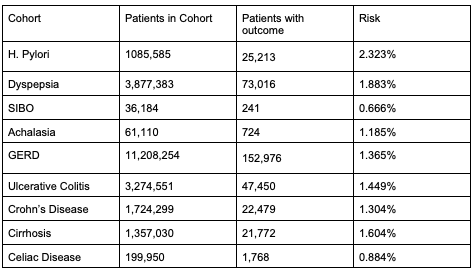Monday Poster Session
Category: Functional Bowel Disease
P2932 - From Gut to Gums: The Overlooked Association Between GI Disorders and Dental Caries
Monday, October 27, 2025
10:30 AM - 4:00 PM PDT
Location: Exhibit Hall

Lina AlQirem, MD
University of Arkansas for Medical Sciences
Little Rock, AR
Presenting Author(s)
Lina AlQirem, MD1, Adalberto Guzman, MD2, Suria Devarapalli, DO1, Ragesh Thandassery, MD3
1University of Arkansas for Medical Sciences, Little Rock, AR; 2University of Arkansas, Little Rock, AR; 3Dept of Solid Organ Transplantation, University of Arkansas for Medical Sciences, Little Rock, AR
Introduction: Dental caries is a common chronic condition globally, influenced by multiple factors including oral hygiene, saliva composition, diet, and systemic health. Albeit less frequently studied, previous studies have shown a higher incidence of dental caries in individuals with gastrointestinal (GI) disorders, including inflammatory bowel disease (IBD) and gastroesophageal reflux disease (GERD). The underlying mechanism remains unclear; in IBD, some studies suggest an altered salivary microbiota may contribute to an increased caries risk. Other disorders, such as GERD or celiac disease, nutrient malabsorption, and chronic acid exposure, may lead to enamel demineralization and bacterial overgrowth. Nonetheless, the relationship between GI disorders and dental caries remains vastly under-investigated. This study aims to evaluate the incidence of dental caries among patients with common GI conditions compared to the general population.
Methods: We conducted a retrospective cohort analysis using the TriNetX research network, which uses de-identified electronic health record globally. Adult patients with diagnosis of selected GI disorders, including Helicobacter pylori (H. pylori) infection, dyspepsia, small intestinal bacterial overgrowth (SIBO), GERD, achalasia, ulcerative colitis (UC), Crohn’s disease (CD), cirrhosis and celiac disease were identified. Within each cohort, the incidence of dental caries was calculated as the proportion of patients with a subsequent dental caries diagnosis. To compare across conditions, risk percentages were additionally used.
Results: A total of 11,208,254 patients with GERD, 3,877,383 with dyspepsia, 1,085,585 with H. pylori, and smaller cohorts for other GI conditions were analyzed. The highest incidence of dental caries was observed in the H. pylori group (2.32%), followed by dyspepsia (1.88%) and cirrhosis (1.60%). Lower rates were seen in patients with UC (1.45%), GERD (1.37%), CD (1.30%), achalasia (1.19%), celiac disease (0.88%), and SIBO (0.67%). Across cohorts, patients with H. pylori and dyspepsia demonstrated a notably higher risk of dental caries compared to other GI conditions.
Discussion: This analysis demonstrated a variable but elevated risk of dental caries in patients with certain GI disorders, specifically H. pylori and dyspepsia. These findings support the importance of overall health surveillance in patients with GI disease and highlight the need for physicians to be aware of the importance of oral health.

Figure: Title: Each cohort with respective outcome and risks in developing dental caries
Disclosures:
Lina AlQirem indicated no relevant financial relationships.
Adalberto Guzman indicated no relevant financial relationships.
Suria Devarapalli indicated no relevant financial relationships.
Ragesh Thandassery indicated no relevant financial relationships.
Lina AlQirem, MD1, Adalberto Guzman, MD2, Suria Devarapalli, DO1, Ragesh Thandassery, MD3. P2932 - From Gut to Gums: The Overlooked Association Between GI Disorders and Dental Caries, ACG 2025 Annual Scientific Meeting Abstracts. Phoenix, AZ: American College of Gastroenterology.
1University of Arkansas for Medical Sciences, Little Rock, AR; 2University of Arkansas, Little Rock, AR; 3Dept of Solid Organ Transplantation, University of Arkansas for Medical Sciences, Little Rock, AR
Introduction: Dental caries is a common chronic condition globally, influenced by multiple factors including oral hygiene, saliva composition, diet, and systemic health. Albeit less frequently studied, previous studies have shown a higher incidence of dental caries in individuals with gastrointestinal (GI) disorders, including inflammatory bowel disease (IBD) and gastroesophageal reflux disease (GERD). The underlying mechanism remains unclear; in IBD, some studies suggest an altered salivary microbiota may contribute to an increased caries risk. Other disorders, such as GERD or celiac disease, nutrient malabsorption, and chronic acid exposure, may lead to enamel demineralization and bacterial overgrowth. Nonetheless, the relationship between GI disorders and dental caries remains vastly under-investigated. This study aims to evaluate the incidence of dental caries among patients with common GI conditions compared to the general population.
Methods: We conducted a retrospective cohort analysis using the TriNetX research network, which uses de-identified electronic health record globally. Adult patients with diagnosis of selected GI disorders, including Helicobacter pylori (H. pylori) infection, dyspepsia, small intestinal bacterial overgrowth (SIBO), GERD, achalasia, ulcerative colitis (UC), Crohn’s disease (CD), cirrhosis and celiac disease were identified. Within each cohort, the incidence of dental caries was calculated as the proportion of patients with a subsequent dental caries diagnosis. To compare across conditions, risk percentages were additionally used.
Results: A total of 11,208,254 patients with GERD, 3,877,383 with dyspepsia, 1,085,585 with H. pylori, and smaller cohorts for other GI conditions were analyzed. The highest incidence of dental caries was observed in the H. pylori group (2.32%), followed by dyspepsia (1.88%) and cirrhosis (1.60%). Lower rates were seen in patients with UC (1.45%), GERD (1.37%), CD (1.30%), achalasia (1.19%), celiac disease (0.88%), and SIBO (0.67%). Across cohorts, patients with H. pylori and dyspepsia demonstrated a notably higher risk of dental caries compared to other GI conditions.
Discussion: This analysis demonstrated a variable but elevated risk of dental caries in patients with certain GI disorders, specifically H. pylori and dyspepsia. These findings support the importance of overall health surveillance in patients with GI disease and highlight the need for physicians to be aware of the importance of oral health.

Figure: Title: Each cohort with respective outcome and risks in developing dental caries
Disclosures:
Lina AlQirem indicated no relevant financial relationships.
Adalberto Guzman indicated no relevant financial relationships.
Suria Devarapalli indicated no relevant financial relationships.
Ragesh Thandassery indicated no relevant financial relationships.
Lina AlQirem, MD1, Adalberto Guzman, MD2, Suria Devarapalli, DO1, Ragesh Thandassery, MD3. P2932 - From Gut to Gums: The Overlooked Association Between GI Disorders and Dental Caries, ACG 2025 Annual Scientific Meeting Abstracts. Phoenix, AZ: American College of Gastroenterology.
